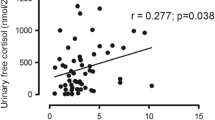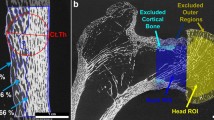Summary
Sixty-two autopsy cases with “itai-itai” or “ouch-ouch” (in English) disease and 50 control subjects were examined by static quantitative bone histopathology. Decalcified sections after cyanuric chloride treatment (Yoshiki's method) [5–7] were used. The small observer variances of the decalcified sections guaranteed the accuracy and precision of this method. In the static measurement analyses, significant increases in formation parameters and decreases in structural parameters were observed (P<0.05–0.000001), suggesting the presence of a marked osteoid accumulation accompanied by a bone mass reduction. Discriminant analysis clearly separated the patients from the control subjects. Two-thirds of the patients showed an increase in resorption surface prior to osteoid deposition and a decrease in osteoblast surface. Double tetracycline labeling in 4 patients showed an impaired osteoid maturation and mineralization. An impaired osteoblastic function was suggested by the results of the static and dynamic histomorphometry. The bone cadmium contents were measured in 46 patients by an atomic absorption spectrophotometer and found to be increased significantly (P<0.01). In Aluminon (an ammonium salt of aurine tricarboxytic acid) staining, a clear, reddish line was located in an osteoid-bone interface, suggesting a reaction of Aluminon with tissue aluminium and/or cadmium. These results suggested that an impairment of osteoblastic function and mineralization occurred in itai-itai disease and that cadmium is a possible etiological factor.
Similar content being viewed by others
References
Takase B (1967) On the pathogenesis of so-called itai-itai disease patients in Toyama Prefecture. Jpn J Clin Med 25:200–219 (in Japanese)
Tsuchiya K (1978) Cadmium studies in Japan: a review. Elsevier, Amsterdam, New York
Nogawa K (1981) Itai-itai disease and follow-up studies. In: Nriagu JO (ed) Cadmium in the environment. John Wiley & Sons, New York, p 1
Ministry of Health and Welfare (1972) Opinion of the Welfare Ministry with the regard to “itai-itai” disease in Toyama prefecture. In: Environment Agency (eds) Control of environmental pollution by cadmium. Environmental Health Division, Planning and Coordination Bureau, Tokyo, Japan, p 199
Yoshiki S (1973) A simple histological method for identification of osteoid matrix in decalcified bone. Stain Technol 48:233–238
Yoshiki S, Tohda H, Chiba I (1974) Further considerations on a simple histological method for identification of osteoid matrix. Stain Technol 49:367–373
Yoshiki S, Ueno T, Akita T, Yamanouchi M (1983) Improved procedure for histological identification of osteoid matrix in decalcified bone. Stain Technol 58:85–89
Villanueva AR (1974) A bone stain for osteoid seams in fresh, unembedded, mineralized bone. Stain Technol 49:1–8
Recker RR, Kimmel DB, Parfitt AM, Davies KM, Keshawarz N, Hinders S (1988) Static and tetracycline-based bone histomorphometric data from 34 normal postmenopausal females. J Bone Min Res 3:133–144
Konno T, Takahashi H (1983) Bone histomorphometry: image analysis. In: Takahashi H (ed) Handbook of bone morphometry. Nishimura Co Ltd, Niigata, p 87
Parfitt AM, Drezner MK, Glorieux FH, Kanis JA, Malluche H, Meunier PJ, Ott SM, Recker RR (1987) Bone histomorphometry: standardization of nomenclature, symbols and units. J Bone Min Res 2:595–610
Vedi S, Compston JE, Webb A, Tighe JR (1982) Histomorphometric analysis of bone biopsies from the iliac crest of normal British subjects. Metab Bone Dis Rel Res 4:231–236
Malluche HH, Sherman D, Meyer W, Manaka R, Massry SG (1982) A new semiautomatic method for quantitative static and dynamic bone histology. Calcif Tissue Int 34:439–448
Marel GM, Mckenna MJ, Frame B (1986) Osteomalacia. In: Peck WA (ed) Bone and mineral research 4. Elsevier, Amsterdam, p 335
Hodkinson HH, Hodkinson I (1980) A discriminant function for the biochemical diagnosis of osteomalacia in elderly subjects and its relevance to interpretation of borderline bone histological findings. J Exp Gerontol 2:123–131
Nogawa K (1980) Comparison of bone lesions in chronic cadmium poisoning and vitamin D deficiency. An experimental study. In: Shigematsu I (ed) Cadmium-induced osteopathy. Japan Public Health Association, Tokyo, p 30
Maloney NA, Ott SM, Alfrey AC, Miller NL, Coburn JW, Sherrard DJ (1982) Histological quantitation of aluminum in iliac bone from patients with renal failure. J Lab Clin Med 99:206–216
Parfitt AM (1983) The physiologic and clinical significance of bone histomorphometric data. In: Recker RR (ed) Bone histomorphometry: techniques and interpretation. CRC Press, Florida, p 143
Meunier PJ (1983) Histomorphometry of the skeleton. In: Peck WA (ed) Bone and mineral research 1. Excerpta Medica, Amsterdam, Oxford, Princeton, p 191
Jowsey J (1977) The bone biopsy. Plenum Medical Book Co, New York, London
Byers P (1977) The diagnostic value of bone biopsies. In: Avioli LV, Krane SM (eds) Metabolic bone disease. Academic Press, New York, London, p 183
Xipell JM, Brown DJ (1979) Histology of normal bone: A computerized study in the iliac crest. Pathology 11:235–240
Malluche HH, Meyer W, Sherman D, Massry SG (1982) Quantitative bone histology in 84 normal American subjects. Calcif Tissue Int 34:449–455
Melsen F, Melsen B, Mosekilde L (1978) An evaluation of the quantitative parameters applied in bone histology. Acta Pathol Microbiol Scand A86:63–69
Ueno T (1985) Comparative study of various methods for identification of osteoid matrix in decalcified bone. Jpn J Oral Biol 27:495–508
Huffer WE, Kuzela D, Popovtzer MM (1975) Metabolic bone disease in chronic renal failure. Am J Pathol 78:365–383
Meunier PJ, Edouard C (1973) Quantification of osteoid tissue in trabecular bone. Methodology and results in normal iliac bone. Proc 1st Intl Workshop Bone Morphometry, Univ. Press, Ottawa, p 191
Meunier PJ, Courpron P (1973) Iliac trabecular bone volume in 236 controls—representativeness of iliac samples. Proc 1st Intl Workshop Bone Morphometry, University Press, Ottawa, p 100
Meyer PC (1956) The histological identification of osteoid tissue. J Pathol Bacteriol 71:325–333
Ralis ZA, Ralis HM (1975) A simple method for demonstration of osteoid in paraffin sections. Med Lab Technol 32:203–213
Tripp EJ, MacKay EH (1972) Silver staining of bone prior to decalcification for quantitative determination of osteoid in sections. Stain Technol 47:129–136
von Kossa J (1901) Über die im Organismus künstlich erzeugbaren Verkalkungen. Beitr Pathol Anat 29:163–202
Villanueva AR, Mehr LA (1977) Modification of the Goldner and Gomori one step trichrome stain for plastic-embedded thin sections of bone. Am J Med Technol 43:536–538
Kitagawa M, Miwa A, Kumada T (1983) A recommendable simple histological preparation for osteoid tissue (Yoshiki's method). Pathol Clin Med 1:155–158 (in Japanese)
Baron R, Vignery A, Horowitz (1983) Lymphocytes, macrophages and the regulation of bone remodeling. In: Peck WA (ed) Bone and mineral research, Annual 2. Elsevier, Amsterdam, p 175
Jaworski ZFG (1983) Histomorphometric characteristics of metabolic bone disease. In: Recker RR (ed) Bone histomorphometry: techniques and interpretation. CRC Press, Florida, p 241
Furuta H (1987) Cadmium effects on bone and dental tissues of rats in acute and subacute poisoning. Experientia 34: 1317–1318
Chang LW, Reuhl KR, Eade PR (1981) Pathological effects of cadmium poisoning. In: Nriagu JO (ed) Cadmium in the environment. John Wiley & Sons, New York, London, p 783
Itokawa Y, Abe T, Tabei R, Tanaka S (1974) Renal and skeletal lesions in experimental cadmium poisoning. Histological and biochemical approaches. Arch Environ Health 28:149–154
Christoffersen J, Christoffersen MR, Larsen R, Rostrup E, Tingsgaard P, Andersen O, Grandjean P (1988) Interaction of cadmium ions with calcium hydroxyapatite crystals: a possible mechanism contributing to the pathogenesis of cadmium-induced bone diseases. Calcif Tissue Int 42:331–339
Ando M, Shimizu M, Matsui S, Sayato Y, Takeda M (1987) Influence of cadmium on the metabolism of vitamin D3 in rats. Toxicol Appl Pharmacol 89:158–164
Bhattacharyya MH, Whelton BD, Stern PH, Peterson DP (1988) Cadmium accelerates bone loss in ovariectomized mice and fetal rat limb bones in culture. Proc Natl Acad Sci USA 85:8761–8765
Bhattacharyya MH, Whelton BD, Peterson DP, Carnes BA, Moretti ES, Toomey JM, Williams LL (1988) Skeletal changes in multiparous mice fed a nutrient-sufficient diet containing cadmium. Toxicology 50:193–204
Miyahara T, Yamada H, Takeuchi M, Kozuka H, Kato T, Sudo H (1988) Inhibitory effects of cadmium on in vitro calcification of a clonal osteogenic cell, MC3T3-E1. Toxicol Appl Pharmacol 96:52–59
Kimura M (1981) Effects of cadmium on growth and bone metabolism. In: Nriagu JO (ed) Cadmium in the environment. John Wiley & Sons, London, New York, p 757
Yoshiki S, Yanagisawa T, Kimura M, Otaki N, Suzuki M, Suda T (1975) Bone and kidney lesions in experimental cadmium intoxication. Arch Environ Health 30:559–562
Müller L, Wilhelm M (1987) Effects of cadmium in rat hepatocytes: interaction with aluminium. Toxicology 44:193–201
Author information
Authors and Affiliations
Rights and permissions
About this article
Cite this article
Noda, M., Kitagawa, M. A quantitative study of iliac bone histopathology on 62 cases with itai-itai disease. Calcif Tissue Int 47, 66–74 (1990). https://doi.org/10.1007/BF02555989
Received:
Revised:
Issue Date:
DOI: https://doi.org/10.1007/BF02555989




